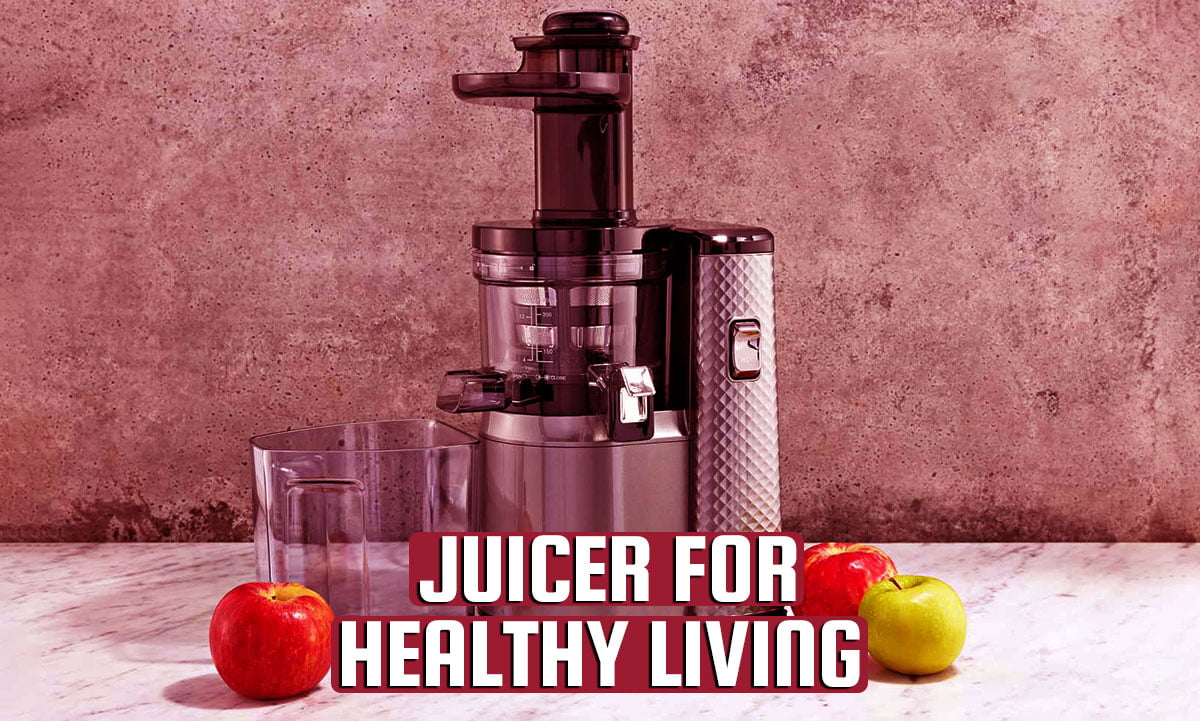Juicing has surged in popularity within the health market, purchasing a juicer an appealing choice for many individuals. If you have already decided to owning a juicer but getting one can be a thoughtful process. With a multitude of options available, each with its unique features, selecting the ideal one that aligns with your preferences and needs becomes essential. In this post, we will know 7 different types of juicer for healthy living.
Before making a purchase, consider a few key questions:
- How much time are you willing to invest in juicing?
- Is juicing a quick, nutritious snack or a dedicated health routine?
- Do you prioritise maximizing nutrient extraction or prioritising convenience?
Different Types of Juicer
Once you have analysed these questions, let us see 7 different types of juicer available to find the perfect match for your requirements.
Table of Contents
1. Centrifugal Force Juicer:
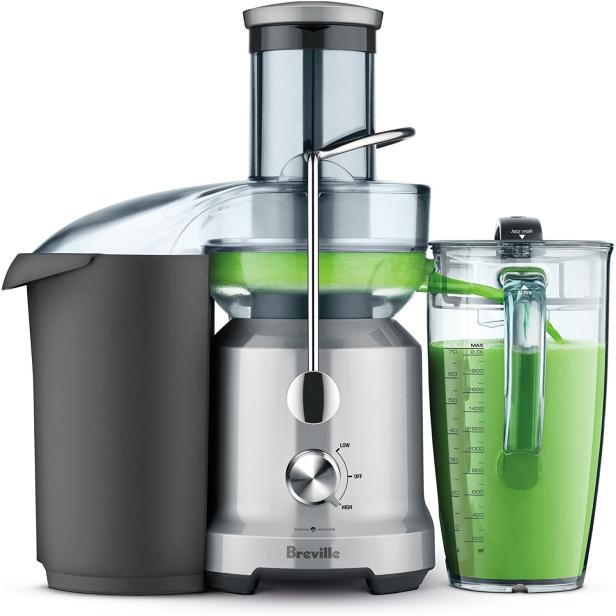
Centrifugal force juicers are best suited for individuals seeking a quick, affordable juicing solution without emphasizing maximum nutrient retention or juicing large quantities at once. They cater to beginners or those looking for immediate juice consumption without much hassle, ideal for a quick nutritional boost. However, for those aiming for superior nutrient extraction or planning to juice leafy greens and wheatgrass frequently, other juicer types might be more suitable.
Pros:
- Fast Extraction: These juicers are exceptionally speedy in extracting juice from various fruits and vegetables, especially when equipped with a wide feed tube allowing whole items like small apples, cucumbers, or oranges to be juiced without pre-cutting.
- Space-Efficient: They possess an upright design, occupying minimal space on kitchen countertops, making them ideal for smaller kitchens.
- Affordability: Centrifugal juicers are usually more budget-friendly compared to other types, making them accessible for individuals on a tighter budget.
Cons:
- Heat Generation: The high-speed rotation generates heat that may degrade the quality of the extracted juice, potentially reducing its nutritional value.
- Oxidation & Foam: Due to rapid spinning, increased oxidation occurs, creating foam on the juice’s surface, leading to quicker separation and potentially altering taste.
- Noise: They can be quite noisy during operation due to their high-speed motors.
- Limited with Greens: Inefficient at juicing leafy greens or wheatgrass compared to other types of juicers, resulting in low extraction and potential wastage.
- Short Shelf Life: Juices from centrifugal force juicers tend to separate quickly, leading to a shorter shelf life, usually only remaining fresh for a matter of minutes.
- High Solids Content: The juice contains a relatively high amount of solids or “pulp,” which may not be ideal for individuals seeking clearer juice consistency.
- Incapability for Nuts & Seeds: Not suitable for juicing nuts or seeds, limiting the capacity to prepare nut milk or similar beverages.
2. Masticating Juicer:
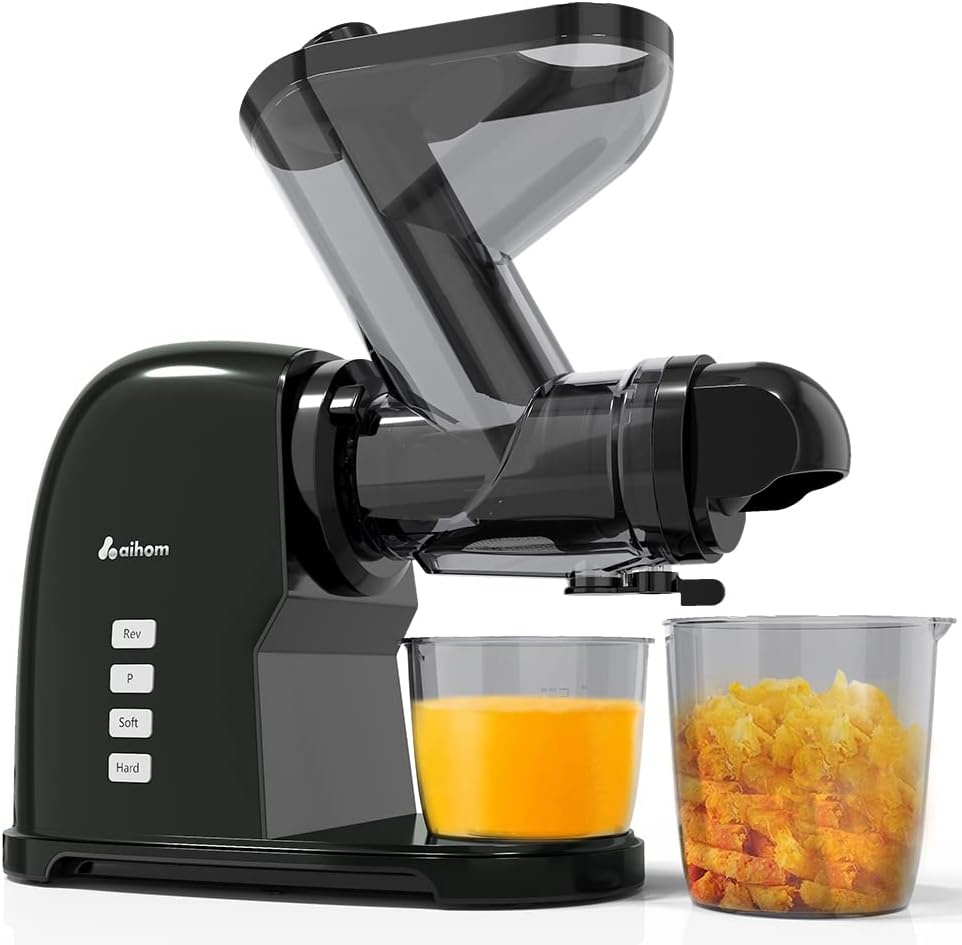
Masticating juicers are suitable for individuals committed to maximizing nutrient retention in their juices, willing to spend more time on preparation and cleaning. They cater well to those interested in green juices and versatile juicing applications beyond traditional fruit and vegetable juices. However, the higher initial investment and the need for additional preparation might not be suitable for everyone, especially those seeking quick and straightforward juicing solutions.
Pros:
- Higher Juice Yield: These juicers tend to yield more juice compared to centrifugal ones, ensuring better extraction, especially with leafy greens and soft fruits.
- Green Juicing Capability: Exceptional at juicing greens like spinach, kale, and wheatgrass, maximizing nutrient extraction and catering to health enthusiasts.
- Reduced Oxidation: They operate at slower speeds, resulting in reduced oxidation during the juicing process, which helps maintain the quality and freshness of the juice for a longer duration.
- Longer Shelf Life: Due to reduced oxidation, juices from masticating juicers can last longer without quick separation or degradation, ensuring a more extended storage life.
- Versatility in Usage: Apart from juicing, these machines can be utilized to create nut butter, baby food, nut milks, frozen treats from frozen fruits, and even function as grain mills.
Cons:
- Prep Work Requirement: They typically have smaller chutes, necessitating more prep work by cutting fruits and vegetables into smaller pieces before juicing.
- Higher Cost: Masticating juicers are generally more expensive compared to centrifugal ones, which might be a deterrent for budget-conscious consumers.
- Cleaning Difficulty: Cleaning masticating juicers can be more intricate due to their design, involving disassembling several parts for a thorough clean, making it relatively more time-consuming.
- Slower Operation: They operate at slower speeds to extract juice thoroughly, which might not suit individuals seeking quick juicing solutions due to the longer processing time.
- Size and Bulkiness: These juicers can occupy more counter space and tend to be bulkier compared to centrifugal ones, which might be inconvenient for smaller kitchens or limited countertop space.
- Higher Pulp Content: The juice tends to have more pulp and indigestible fiber, which might not be preferable for those looking for a clearer juice texture.
3. Twin Gear Juicer:
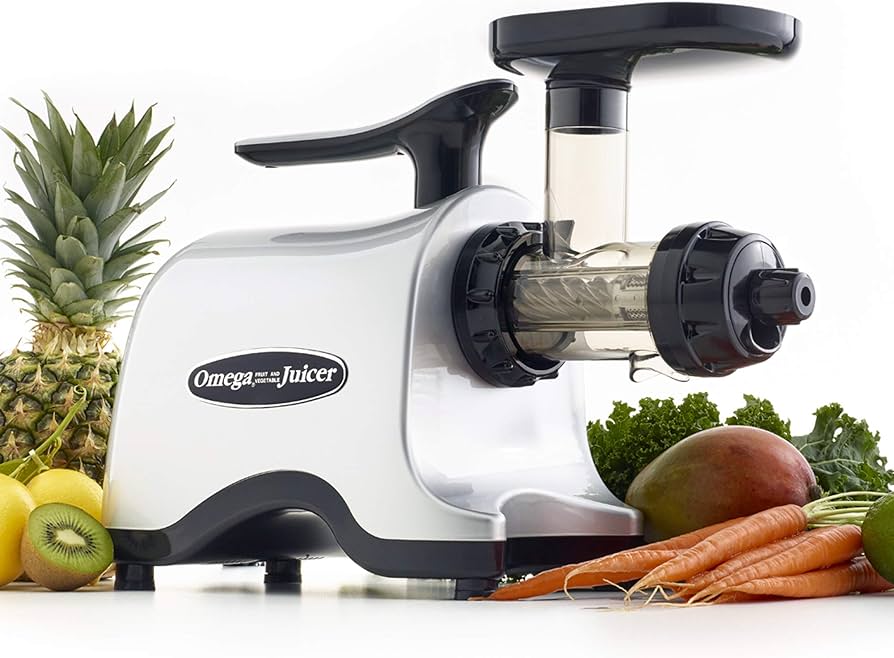
Twin gear juicers are known for their superior nutrient extraction capabilities and versatility in producing various food items beyond juices. However, their higher cost, slower operation, and more complex cleaning process might not be suitable for everyone, especially those looking for a more budget-friendly or quick juicing solution.
Pros:
- Enhanced Nutrient Extraction: Believed to extract more nutrients compared to centrifugal or masticating juicers, ensuring higher-quality juice with better nutrient retention.
- Versatile Functions: Capable of creating various food items apart from juice, including baby food, nut butter, sorbets, and pasta, offering diverse culinary options.
- Quiet Operation: Twin gear juicers operate quietly compared to some other types, making them suitable for use without causing disturbance.
Cons:
- Higher Cost: Generally more expensive than centrifugal or masticating juicers, which might deter budget-conscious buyers from choosing this option.
- Slow Operation: They work at a slower pace compared to other juicers, resulting in longer processing times, which may not be ideal for those seeking quick juicing solutions.
- Size and Space Requirement: These juicers might occupy more countertop space than centrifugal models, making them less suitable for kitchens with limited space.
- Complex Cleaning: Cleaning twin gear juicers can be more complicated due to their design, involving multiple parts that need disassembly, making the cleaning process more time-consuming.
- High Pulp Content: The juice extracted from twin gear juicers might contain a higher amount of solids or “pulp,” which may not suit preferences for a clear juice texture.
4. Citrus Juicers:
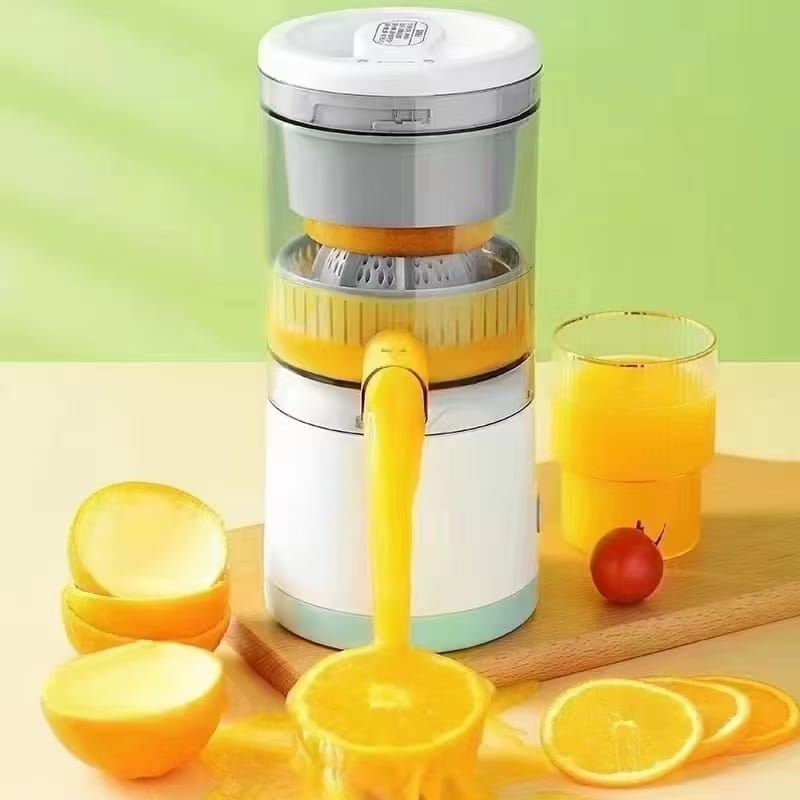
Citrus juicers excel in efficiently extracting juice from citrus fruits, offering ease of use and suitability for businesses where these fruits are a primary focus. However, their restricted compatibility with only citrus fruits and limited versatility might limit their appeal for users seeking a juicer capable of handling various types of produce beyond just citrus fruits.
Pros:
- Efficient Citrus Extraction: Specifically designed for citrus fruits like lemons, limes, and oranges, efficiently extracting juice from these fruits with minimal effort.
- Medium-Volume Use: Suited for medium-volume use in bars, restaurants, and concessions, making them ideal for establishments where citrus juice is frequently needed.
- Ease of Use: Simple and straightforward operation, usually involving motorized spinning reamers or manual press mechanisms for extracting juice.
- Specific Fruit Suitability: Tailored for extracting juice from specific citrus fruits, providing an optimal solution for establishments focusing on these fruits in their offerings.
Cons:
- Limited Fruit Compatibility: Primarily designed for citrus fruits only, restricting their functionality to extracting juice solely from lemons, limes, oranges, or grapefruits.
- Single Purpose: Limited use in comparison to multi-purpose juicers that handle a wider range of fruits and vegetables, making them less versatile for diverse juicing needs.
- Restricted Application: Limited to certain businesses or individuals who predominantly use citrus fruits, potentially reducing their utility for those requiring a more comprehensive juicing solution.
5. Wheatgrass Juicers:
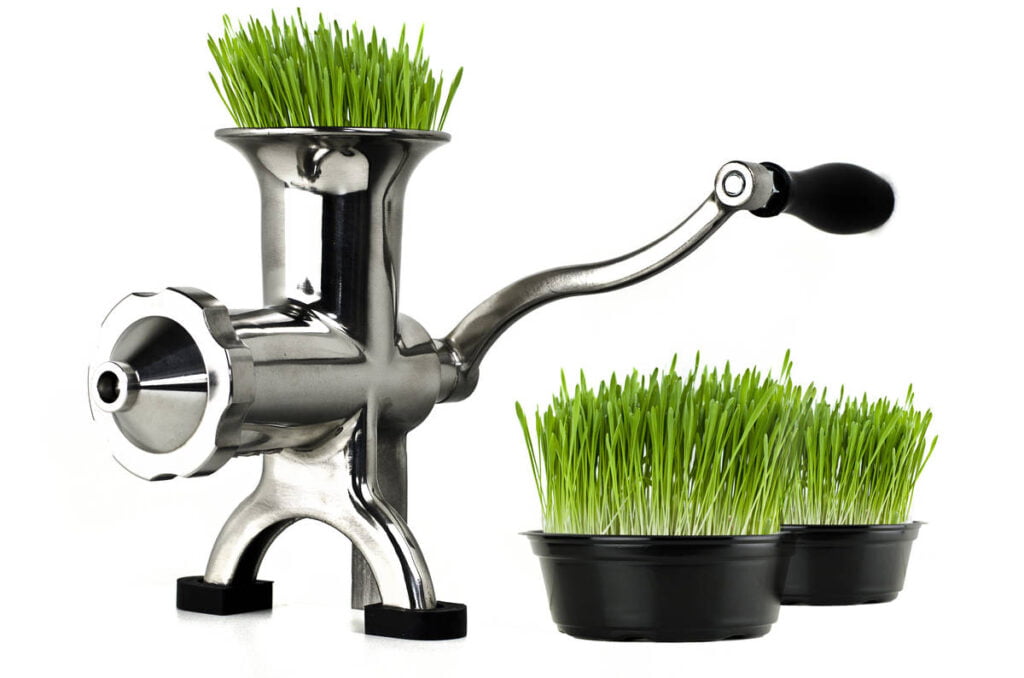
Wheatgrass juicers excel in efficiently extracting juice from wheatgrass, sprouts, and leafy greens, making them ideal for businesses or individuals focusing on these specific types of produce. However, their limited versatility and niche functionality may limit their appeal for users requiring a juicer capable of handling a wider range of fruits and vegetables beyond grasses and leafy greens.
Pros:
- Designed for Grasses and Leafy Greens: Specifically tailored for processing wheatgrass, sprouts, herbs, and other leafy greens, allowing efficient extraction of juice from these delicate items.
- Medium to High-Volume Use: Suited for medium to high-volume use in juice bars, spas, restaurants, or cafes, making them suitable for establishments with frequent wheatgrass juice demands.
- Specialized Functionality: Dedicated machines for grasses and leafy greens, ensuring optimal extraction of juice while retaining vital nutrients present in these greens.
- Focused Application: Ideal for businesses or individuals focusing on wheatgrass and leafy greens, offering a targeted solution for their juicing needs.
Cons:
- Limited Versatility: Restricted functionality to grasses, herbs, and leafy greens only, limiting their utility for those seeking a juicer capable of processing a wider variety of fruits and vegetables.
- Single-Purpose Juicing: Lack of versatility compared to multi-purpose juicers that can handle a broader range of produce, potentially reducing their appeal for users with diverse juicing requirements.
- Niche Market: Limited application and appeal primarily to businesses or individuals specifically seeking wheatgrass or leafy green juicing, potentially making them less attractive for broader juicing needs.
6. Reamer Juicers:
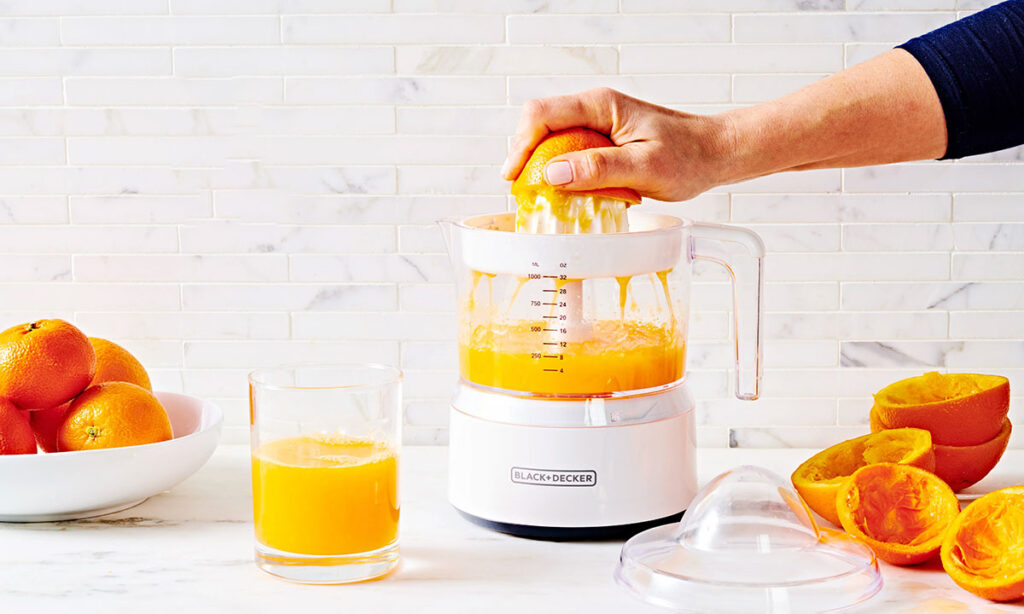
Reamer juicers are ideal for small-scale operations like bars or cafes with occasional juicing needs for citrus fruits. They are user-friendly, cost-effective, and space-efficient. However, their manual operation and fruit-specific functionality might not be suitable for businesses requiring higher juicing capacities or versatility with various types of fruits and vegetables beyond citrus.
How to Use:
- Preparation: Halve the fruit vertically.
- Extraction: Take the halved fruit and press the reamer, a handheld tool with a ridged tip, firmly into the cut side of the fruit.
- Twisting Motion: Apply firm pressure and twist the reamer against the fruit to effectively release and extract the juice.
- Extract Juice: The ridges on the reamer aid in breaking down the fruit’s pulp, allowing the juice to flow out easily.
Pros:
- Simplicity: These juicers are straightforward and easy to use, requiring minimal effort or expertise.
- Cost-effective: Often more affordable compared to electric juicers, making them suitable for establishments with low-volume juicing needs.
- Space-saving: Being manual and handheld, they are compact and do not require much storage space.
Cons:
- Limited Capacity: Designed for low-volume use, making them less efficient for larger quantities of juice.
- Labor-Intensive: Manual operation involves physical effort, potentially making it less suitable for continuous or high-volume juicing.
- Fruit-Specific: Primarily suitable for specific citrus fruits (lemons, limes, oranges, grapefruit), limiting their versatility for other types of produce.
7. Orange Juice Machine
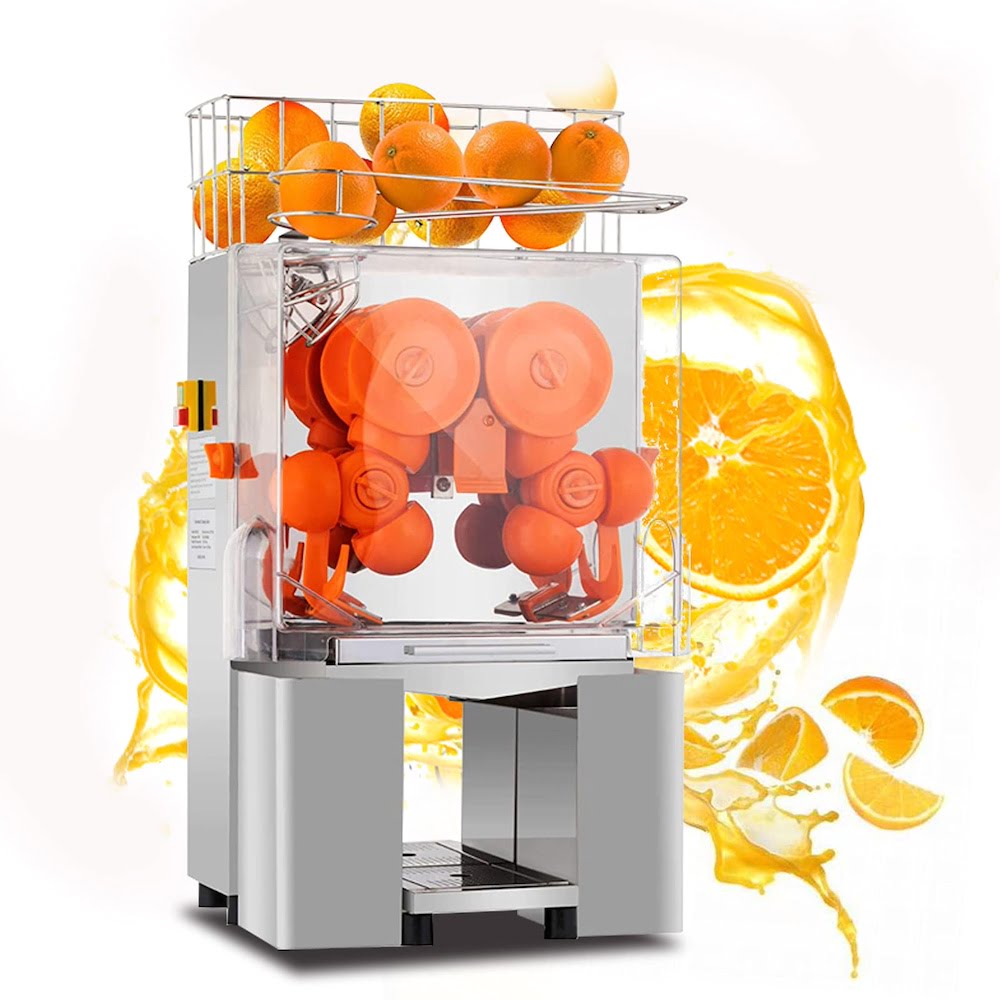
Orange juice machines are ideal for businesses like markets, spas, hotels, restaurants, or cafes requiring a consistent supply of fresh orange juice in medium to high volumes. While they offer efficiency, consistency, and ease of operation for orange juicing, their limited use for oranges and potential maintenance requirements should be considered when choosing a juicing solution for varied needs.
How to Use:
- Preparation: Ensure that the machine is properly set up and ready for operation.
- Feeding Chute: Place the oranges in the feeding chute of the machine.
- Operation: The operation of orange juice machines may slightly vary depending on the model.
- In general, press the lever or button designated for squeezing juice.
- The machine will extract the juice from the oranges placed in the feeding chute.
- Squeezing Process: The machine will automatically squeeze the oranges to extract the juice.
- Completion: Press the stop button or release the lever when the juicing process is finished.
Pros:
- High Volume Juicing: These machines are specifically designed to handle a high volume of oranges, making them ideal for businesses requiring a constant supply of orange juice.
- Efficiency: They automate the juicing process, saving time and effort compared to manual methods.
- Consistency: The machine maintains a consistent quality and quantity of juice produced.
- Ease of Operation: Simple controls make them easy to operate, requiring minimal training for staff.
Cons:
- Limited Use: Primarily designed for oranges, limiting their utility for other fruits or vegetables.
- Size: Some models might be larger and require more space compared to other manual or smaller juicing options.
- Maintenance: Regular cleaning and maintenance are essential to ensure proper functioning, which might require effort and time.
How to Choose a Juicer for Your Need
Think about what kinds of fruits and veggies you want to juice and how much juice you will make—enough for one person or enough to last the whole week. Masticating juicers can squeeze out more juice to make a drier pulp and work well with leafy greens. Centrifugal juicers can make a lot of juice quickly.
i. Speed
To go over this idea again, the difference between slow and fast depends on how quickly you need your juice—seconds or minutes. Centrifugal juicers make a lot of juice quickly, while slow juicers work more slowly but give you the most protein.
ii. Noise
If you want to use your blender first thing in the morning, the noise level might be something you think about. Some centrifugal juicers are loud, more like blenders. Slow juicers, on the other hand, make a lower decibel hum when they work.
iii. Size
As there are different kinds of juicers, you should think about things like their height, weight, and where you will keep them. Not all juicers can fit in a closet, and some may be too heavy to move around.
iv. Ease of Use
Think about how much time you have to prepare and clean up, as well as how easy it is to use in general. Centrifugal and citrus designs are good for people who are just starting to juice. On the other hand, people who want to invest in their juicer may want to take the time to learn how to use a masticating design.
Benefits of Fresh Juice:
Freshly-squeezed juice is packed with essential vitamins and nutrients, presenting an appealing option for health-conscious individuals. Incorporating fresh juices into your menu offers numerous benefits:
- Reduce Waste: Utilize overripe produce by transforming it into nutritious juices.
- Profit Margins: Fresh juice products often have high-profit margins with minimal overhead.
- All Day Sales: Versatile—can complement various meal times and occasions.
- On Trend: Caters to the growing demand for healthy, trendy options.
- Healthy Option: Attracts health-conscious customers seeking nutritious alternatives.
- Seasonal Appeal: Showcases seasonal, locally-sourced ingredients, fostering community engagement.
The Health Benefits of Juicing:
Freshly-squeezed juice contains an array of beneficial nutrients, offering a flavorful and healthy alternative. While juicing is a great way to incorporate more fruits and vegetables into one’s diet, it’s important to note that it’s not a complete substitute for whole foods, as they offer essential fiber and nutrients.
In conclusion, freshly-squeezed juice is undeniably a healthy and refreshing addition to any menu or personal diet. However, it should complement a balanced intake of whole fruits and vegetables to maximize health benefits.
Understanding the diverse range of juicers available and their respective functionalities will empower you to select the most suitable option based on your needs, whether for personal use or a business venture.

